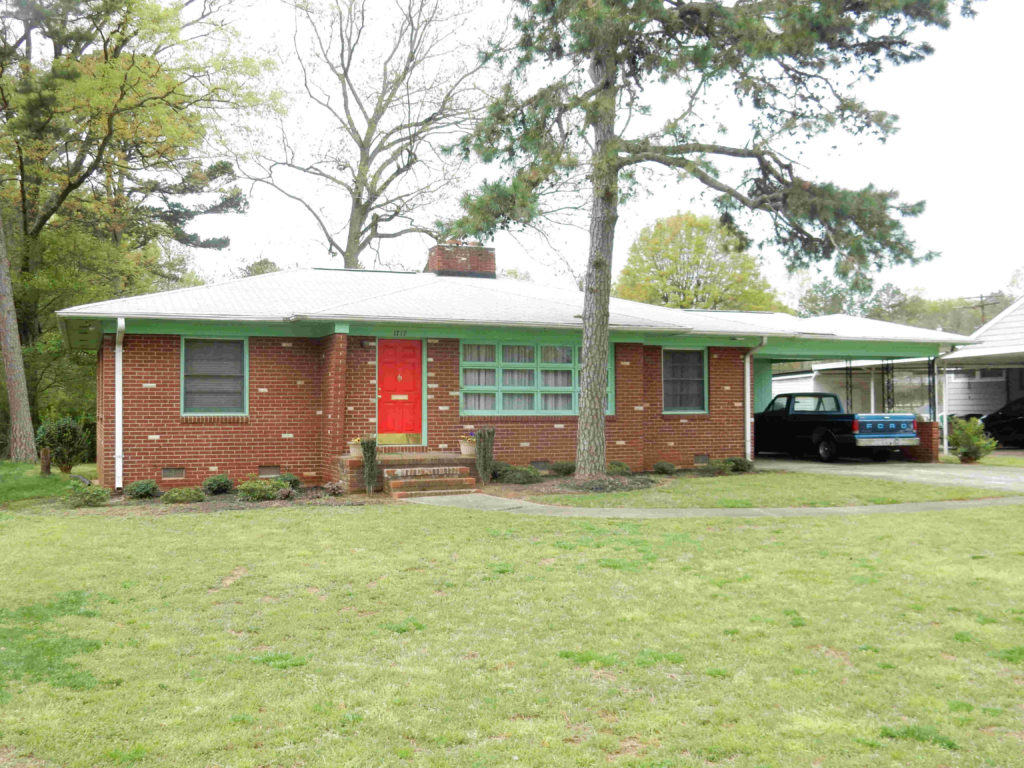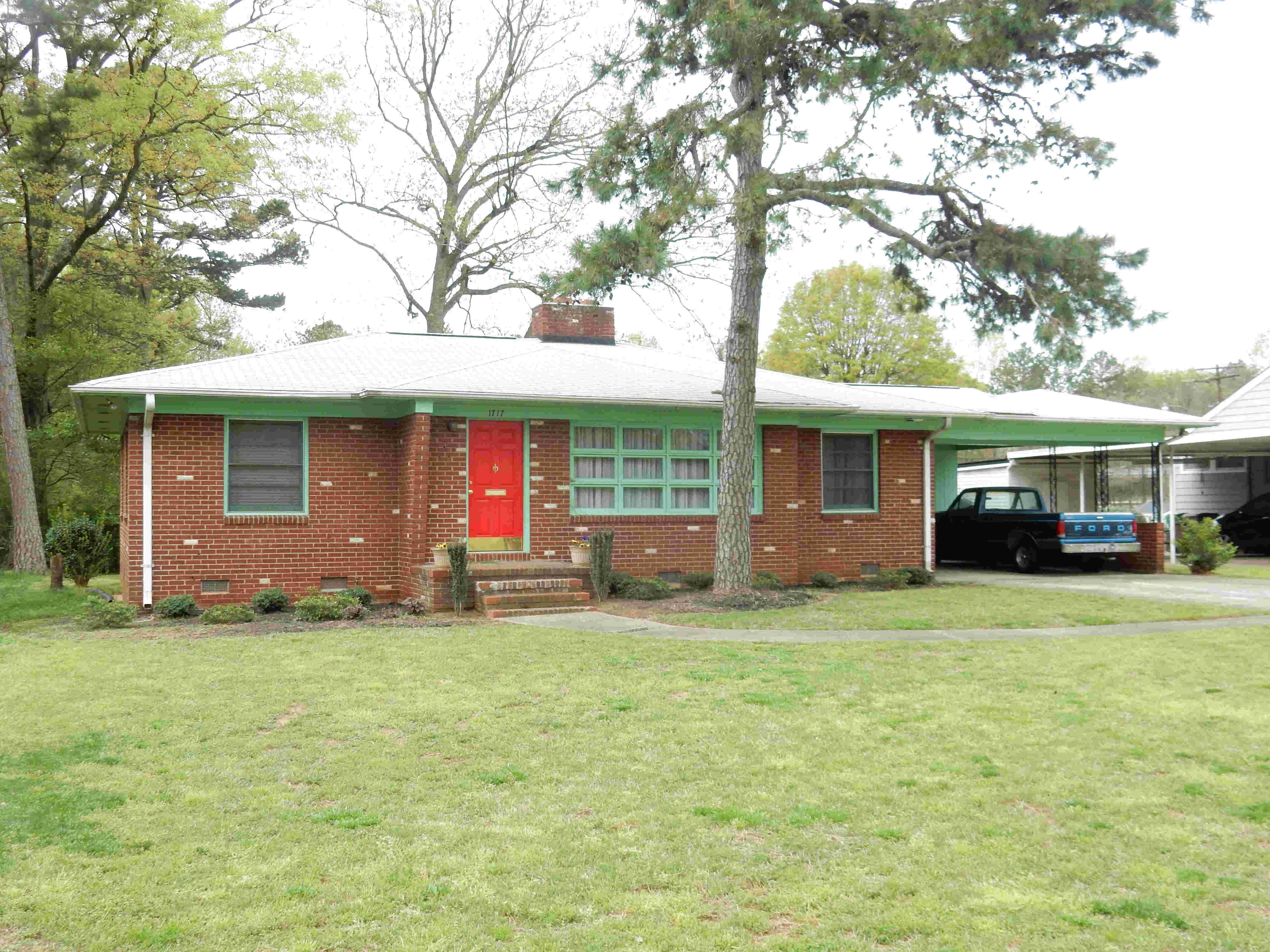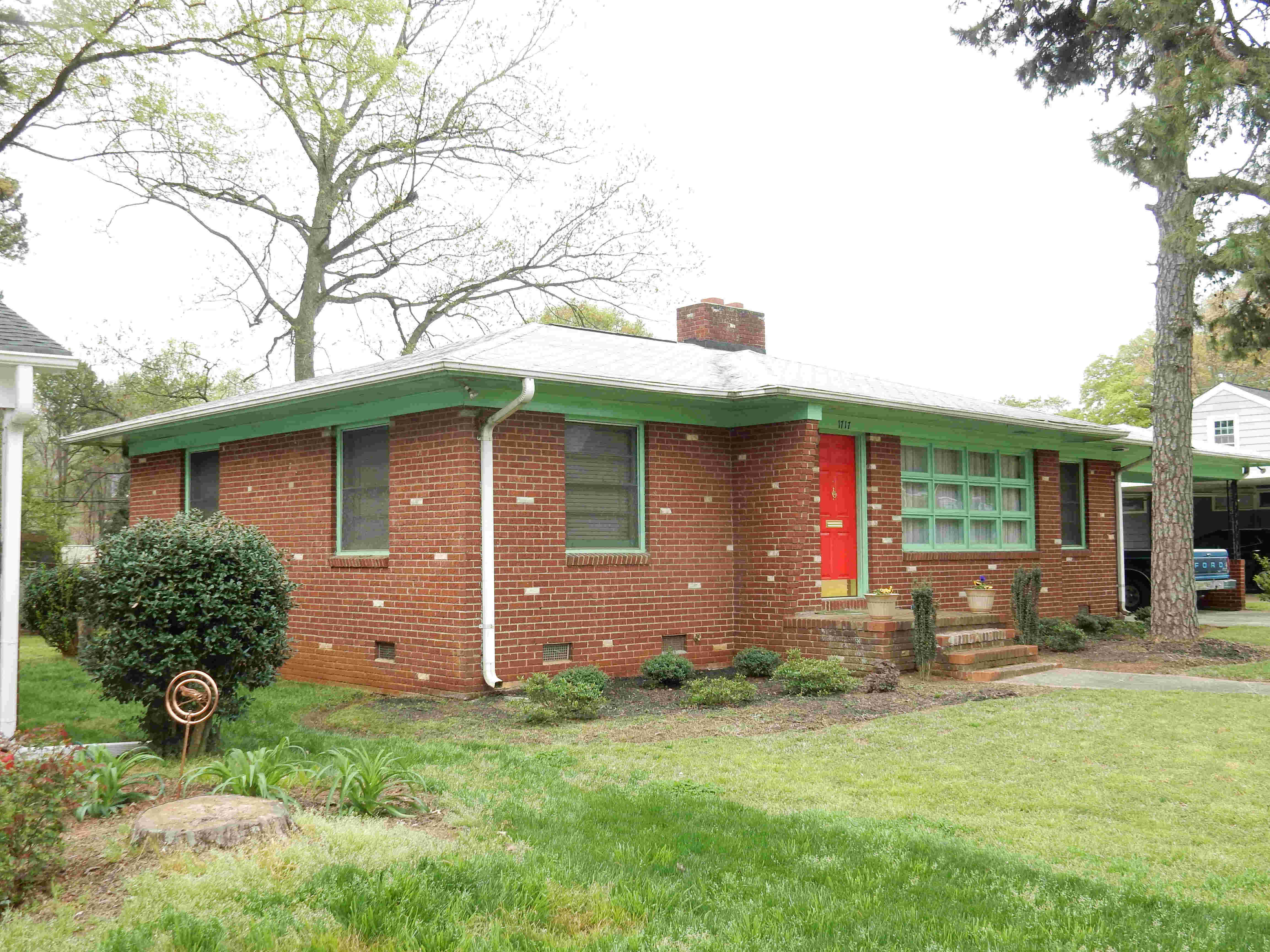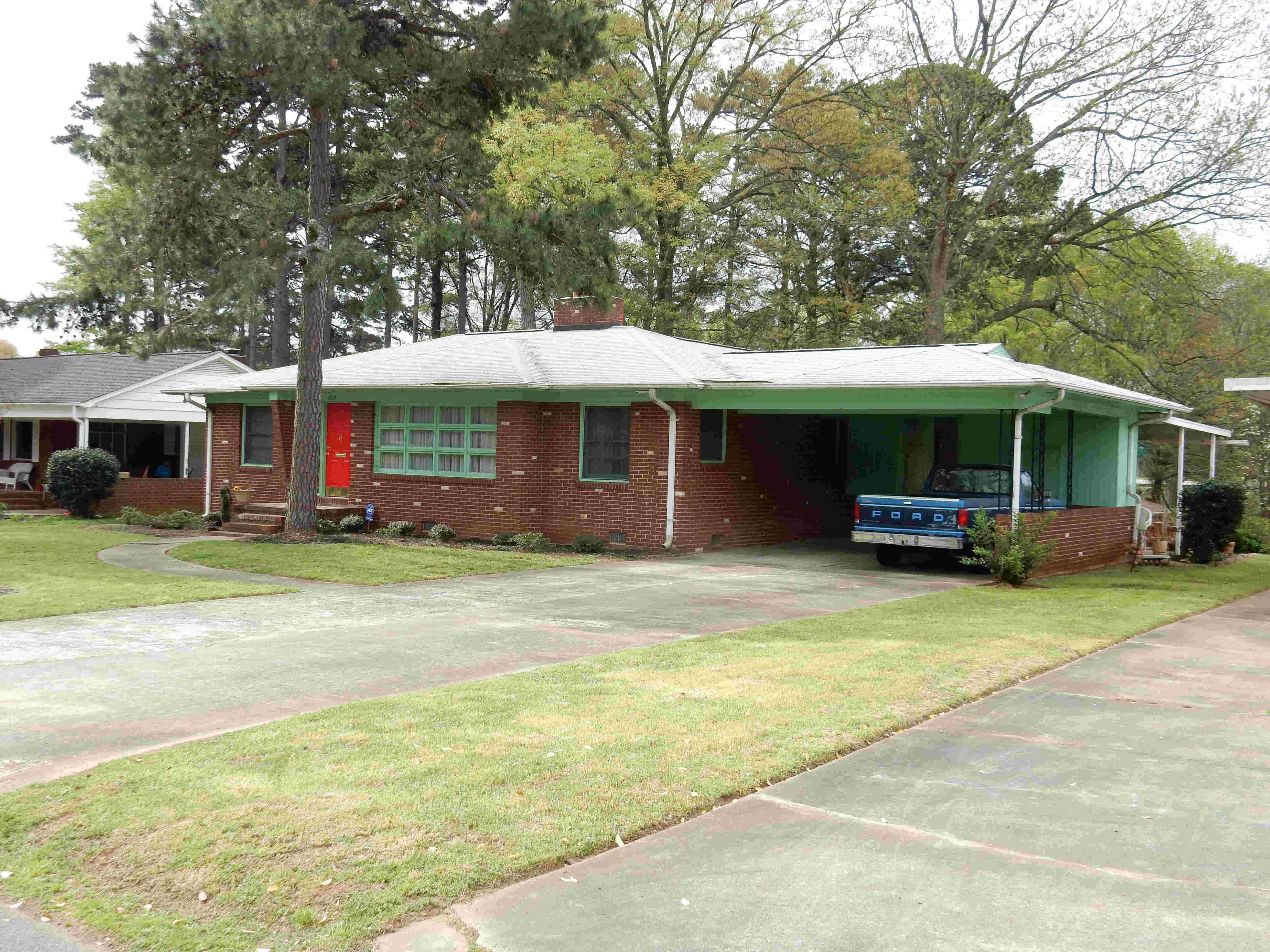1717 Madison Avenue
 Built speculatively in 1956-57 by Ed Griffin, who developed a handful of McCrorey Heights houses, but quickly sold to William C. Covington, who lived there for nearly six decades. Covington was a Civil Rights pioneer, one of Charlotte’s first African American policemen. His wife Johnsie Jackson Covington was a longtime educator in Charlotte Mecklenburg Schools.
Built speculatively in 1956-57 by Ed Griffin, who developed a handful of McCrorey Heights houses, but quickly sold to William C. Covington, who lived there for nearly six decades. Covington was a Civil Rights pioneer, one of Charlotte’s first African American policemen. His wife Johnsie Jackson Covington was a longtime educator in Charlotte Mecklenburg Schools.
* * *
When Covington died in 2016, his passing merited a lengthy feature story by Charlotte Observer columnist Mark Washburn:
“He joined the Charlotte Police Department in an age when black officers were not permitted to drive police cruisers. He pioneered community policing decades before it was officially invented and ran one of the best burger joints in town.
William Covington, 90, who died Monday of colon cancer at his Charlotte home, was an inspiring figure in Charlotte’s African-American community in the 1950s in part because of his unusual approach to police work.
“He thought of himself more as a case worker than a police officer,” said his daughter, Sheron Patterson. “He spent a lot of time with alcoholics – back then they were called drunks – getting to know them and trying to get them to come out of that situation and be productive citizens.” She remembered one day a man came up to Covington and embraced him. “He said, ‘You helped me from killing myself, my wife and children. If you hadn’t come by the house, I would have killed everybody.”
Later, as a school resource officer in the late ’70s at Spaugh Junior High, he was known for showing up at the homes of perpetually tardy students to wake them up. When students were absent for a time, he would go to their homes to make sure they were OK – and a few weren’t, after their mothers learned they hadn’t been in classes.
Covington was born on June 26, 1926, in a house on Condon Street, off Oaklawn Avenue about two blocks from Oaklawn Cemetery, where he will be buried Saturday. He played tackle for West Charlotte High School from 1943 to 1946. At halftime, he’d put a band jacket over his uniform and play first saxophone in the band.
He graduated from Johnson C. Smith University with a biology degree in 1950, then was drafted into the Army and stationed in Germany. He later studied photography in New York on the GI Bill but couldn’t make a living at it. He joined the Charlotte Police Department in 1954.
Charlotte integrated its force in 1946, considered a progressive step in the South at the time, but black officers were in a different corps than whites. They could only patrol the black districts, and arresting whites was considered a violation of community norms.
They were restricted to foot patrol, and he got to know his community because people would invite him into their homes to warm up during the winters.
“On his first day, he went into the police station and he was stopped by an officer when he tried to go into the changing room,” Patterson said. “He was told, ‘No, the Negroes change downstairs with the Negro janitors and maids.’
“He came to find out the Negro janitors and maids always kept food cooking downstairs on hot plates – chicken, chitlins, collard greens, cobbler. Pretty soon he was going in to work two hours early.”
He helped found the N.C. Organization of Black Police Officers, which supported equality among those in the profession. He was part of the team that successfully sued the Charlotte Police Department over discriminatory practices in the 1970s.
Inspired others
In the African-American community in the 1950s, the black officers in crisp uniforms and gleaming badges were top role models and held in high esteem.
Sometimes he would visit his wife, Johnsie, who taught at Lincoln Heights Elementary School in the late ’50s. “He’d come and we’d run to the window – our hero had appeared,” said Brad Humphrey, a third-grader then. “It was better than Superman. To see him in our community was something to behold. We appreciated who he was and what he did and what he represented, and we wanted to be like him.”
Humphrey, pastor of First Fellowship Ministries of Charlotte on Lawyer’s Road, never imagined that one day Covington might join his congregation. Covington started coming about five years ago after attending Mount Carmel Baptist Church on Tuckaseegee Road for decades. “He was an avid Bible scholar,” said Humphrey, “always had a word of wisdom to share with our congregation, and gave counsel to the young people everywhere he went.”
Burger master
Covington also operated the West Charlotte Drive In, a soul food restaurant and social hot-spot on Beatties Ford Road from the ’60s to the early ’80s. It claimed to have the world’s juiciest hamburgers, and no one ever sued it for misrepresentation. “He was not worried when the McDonald’s chain moved in,” said Patterson, “because he knew his burgers were always going to be juicier and bigger. And they were.”
He overcame a speech impediment – he would stutter at times – by memorizing and repeating limericks and poems, Patterson said. Long after he’d mastered his speech, he kept entertaining others with new poetic material.
Patterson, an only child, was known in her neighborhood as “Policeman’s Daughter.” And it had certain perks. When she was 11, the Jackson 5 came to Charlotte. She got to go and meet them. “Because all his friends were backstage guarding them,” she said. Michael Jackson was shy and quiet, she said, “just a little thing.”
* * *
Johnsie Jackson Covington was born the ninth of ten children in York County, just over the South Carolina border from Charlotte. Her family moved up to Charlotte in time for her to graduate from West Charlotte High School. She went to Bennett College, the highly regarded African American women’s college in Greensboro, for a degree in Child Development. She would eventually earn a Masters in Education from Columbia University’s Teachers College in New York City.
Teaching became her life work. “She maintained a deep love for children and dedicated herself to elementary age education,” said her funeral program. Johnsie Covington taught for thirty-five years at Charlotte elementary schools including Biddleville, Isabella Wyche, Hidden Valley and Lincoln Heights.
She also maintained an active community life: a member of Delta Sigma Theta Sorority; a founder of the Charlotte chapter of Chums, Incorporated; and active in another social/service club Tots and Teens. In a neighborhood where most families were Presbyterian, Baptist or AME Zion, Johnsie Covington was among the few Methodists. Her service to Simpson Gillespie United Methodist Church included chairing its Board of Trustees.
Johnsie and William met in 1948 and married in 1954, moving into this handsome new house in McCrorey Heights four years later. They raised one child here, daughter Sheron Covington Patterson. In 2015 Reverend Dr. Sheron Covington Patterson served on the Board of Trustees at Southern Methodist University in Dallas, Texas.



Architecture
Ranch style house, one-story in brick, with Modernistic touches. There is a main hip roof, low-pitched to emphasize horizontality. It extends at the east side to form a two-vehicle carport. At the front of the house the roof extends slightly, supported by one outward-stepping brick column, to shelter the front door. Note the picture window formed by 12 smaller horizontal panes. A few yellow bricks are randomly dotted among the red bricks in the exterior walls.
In 1969, longtime owner William Covington hired Mangie McQueen — one of the city’s busiest African American contractors and a McCrorey Heights neighbor — to build a substantial additional at the rear of the dwelling.
Building permits
Madison 1717 permit c
Date issued: December 7, 1956
Owner: Ed Griffin
Contractor: Geo. D. Sanford
Estimated cost:
Other permit info: This permit is for wiring, as is second permit October 11, 1956
Madison 1717 permit b
Date issued: February 5, 1969
Owner: W. C. Covington, Jr.
Contractor: Mangie McQueen
Estimated cost: $10,000
Other permit info: rear addition: bedroom, den and bath
Madison 1717 permit a
Date issued: July 24, 1974
Owner: W. C. Covington
Contractor: Mangie McQueen
Estimated cost: $725
Other permit info: Res. Re-roof
First appeared in city directory
1958 – William C. Covington & Johnsie.
He: City police.
She: Teacher, Biddleville School
1981 city directory – still listed. He: Empl. City of Charlotte. She: no occupation listed.
obituary
Resources
Powell, Chaitra, “An African American First Responder: An Oral History with William C. Covington,” on the website: Southern Sources: Exploring the Southern Historical Collection, posted July 15, 2015. On-line at: http://blogs.lib.unc.edu/shc/index.php/2015/07/15/an-african-american-first-responder-an-oral-history-with-william-c-covington/
“William Covington Dies, Pioneer Black Police Officer and ‘Superman’ to Kids,” Charlotte Observer, August 10, 2016. On-line at: http://www.charlotteobserver.com/news/local/news-columns-blogs/mark-washburn/article94926562.html